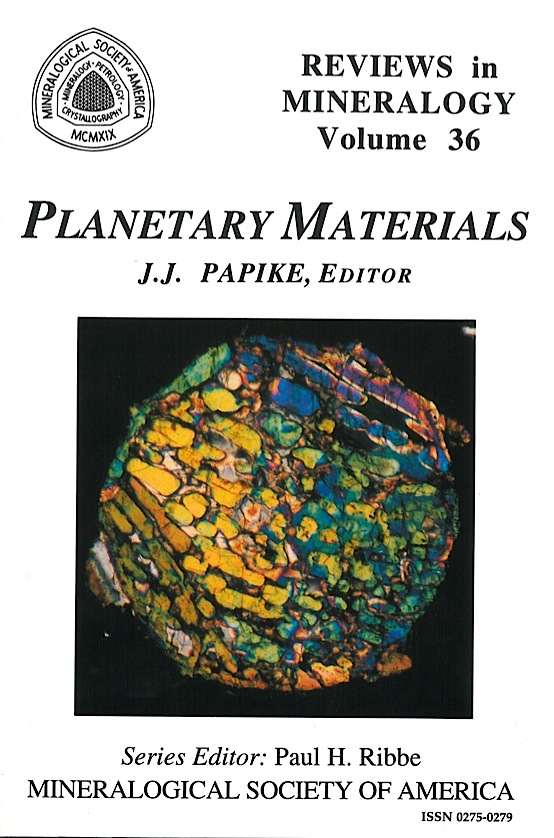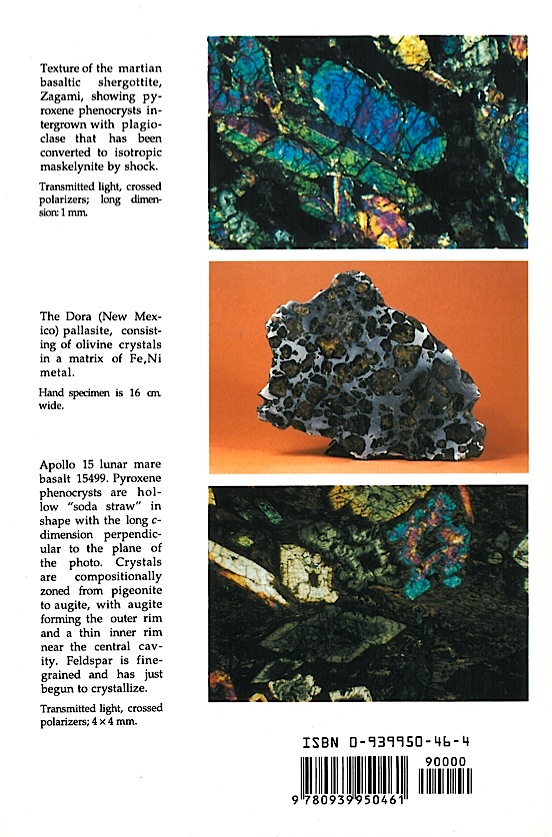

Mineralogical Society of America, Founded December 30, 1919
Order Publications Online (25% discount for MSA, CMS and GS members, except shipping)
MinPubs.org Pay-Per-View GeoScienceWorld Pay-Per-View


1998 i-xx + 864 pages. ISBN 0-939950-46-4; ISBN13 978-0-939950-46-1
We seek to understand the timing and processes by which our solar system formed and evolved. There are many ways to gain this understanding including theoretical calculations and remotely sensing planetary bodies with a number of techniques. However, there are a number of measurements that can only be made with planetary samples in hand. These samples can be studied in laboratories on Earth with the full range of high-precision analytical instruments available now or available in the future. The precisions and accuracies for analytical measurements in modern Earth-based laboratories are phenomenal. However, despite the fact that certain types of measurements can only be done with samples in hand, these samples will always be small in number and not necessarily representative of an entire planetary surface. Therefore, it is necessary that the planetary material scientists work hand-in-hand with the remote sensing community to combine both types of data sets. This exercise is in fact now taking place through an initiative of NASA's Curation and Analysis Planning Team for Extraterrestrial Materials (CAPTEM). This initiative is named "New Views of the Moon: Integrated Remotely Sensed, Geophysical, and Sample Datasets." As preliminary results of the Lunar Prospector mission become available, and with the important results of the Galileo and Clementine missions now providing new global data sets of the Moon, it is imperative that the lunar science community synthesize these new data and integrate them with one another and with the lunar-sample database. Integrated approaches drawing upon multiple data sets can be used to address key problems of lunar origin, evolution, and resource definition and utilization.
The idea to produce this Reviews in Mineralogy (RIM) volume was inspired by the realization that many types of planetary scientists and, for that matter, Earth scientists will need access to data on the planetary sample suite. Therefore, we have attempted to put together, under one cover, a comprehensive coverage of the mineralogy and petrology of planetary materials. The book is organized with an introductory chapter that introduces the reader to the nature of the planetary sample suite and provides some insights into the diverse environments from which they come. Chapter 2 on Interplanetary Dust Particles (IDPs) and Chapter 3 on Chondritic Meteorites deal with the most primitive and unevolved materials we have to work with. It is these materials that hold the clues to the nature of the solar nebula and the processes that led to the initial stages of planetary formation. Chapter 4, 5, and 6 consider samples from evolved asteroids, the Moon and Mars respectively. Chapter 7 is a brief summary chapter that compares aspects of melt-derived minerals from differing planetary environments.
Jim Papike, Albuquerque, New Mexico, USA
July 1, 1998
Planetary Materials was the brain-child of James J. Papike, recent President of the Mineralogical Society of America and current Director of the Institute of Meteoritics at the University of New Mexico. It was probably not intentional that this volume be the largest ever produced in the Reviews in Mineralogy series, but this work has exceeded by nearly 200 pages the next smaller volume (33). Perhaps it is no coincidence that both books were produced apart from MSA short courses-the normal venue for most of the RiM volumes.
Given the sheer mass of material, this tour de force of Solar System mineralogy has been handled differently than most books in the series: pagination is by chapter, i.e. the pages in Chapter 1 are numbered 1-1, 1-2, 1-3, etc. and those in Chapter 2,2-1,2-2,2-3, etc. This facilitated indexing and increased the speed of publication. Indexes are luxuries in the RiM series because publication deadlines are usually too short for most volumes, but, thankfully, the 1039-page text of Planetary Materials was indexed by the above-named parents-a heroic and absolutely essential undertaking for such an encyclopedic work.
Paul H. Ribbe, Blacksburg, Virginia, USA, Series Editor
September 10, 1998
Title Page
p. i
Copyright
p. ii
List of volumes currently available in the Reviews in Mineralogy series
p. iii
Foreword
p. iv
Preface
p. v - vi
Table of Contents
p. vii - xvi
Chapter 1. The Planetary Sample Suite and Environments of Origin
by Charles K. Shearer, James J. Papike., and Frans J.M. Rietmeijer, p. 1-01 - 1-28
Chapter 2. Interplanetary Dust Particles
by Frans J.M. Rietmeijer, p. 2-01 - 2-96
Chapter 3. Chondritic Meteorites
by Adrian J. Brearley and Rhian H. Jones, p. 3-001 - 3-398
Chapter 4. Non-Chondritic Meteorites from Asteroidal Bodies
by David Wayne Mittlefehldt, Timothy J. McCoy, Cyrena Anne Goodrich, and Alfred Kracher, p.4-001 - 4-196
Chapter 5. Lunar Samples
by James J. Papike, G. Ryder, and Charles K. Shearer, p. 5-001 - 5-234
Chapter 6. Martian Meteorites
by Harry Y. McSween, Jr. and Allan H. Treiman, p. 6-01 - 6-54
Chapter 7. Comparative Planetary Mineralogy: Chemistry of Melt- Derived Pyroxene, Feldspar, and Olivine
by James J. Papike, p. 7-01 - 7-12
Index
p. I-1 - I-24
Lunar Sample Index
p. 1 - 2